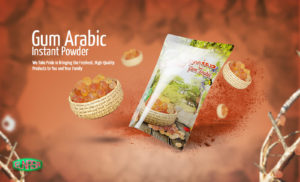
Geneva, Switzerland, 24 April 2018 – Steeped in legend, gum arabic is not only an exotic commodity but also has the power to drive development in the African nations that produce it, some of them the poorest nations in the world.
In a special gum arabic-themed issue of its Commodities at a Glance (http://unctad.org/en/PublicationsLibrary/suc2017d4_en.pdf?utm_source=UNCTAD+Media+Contacts&utm_campaign=5fa6f4d47e-EMAIL_CAMPAIGN_2018_04_24&utm_medium=email&utm_term=0_1b47b7abd3-5fa6f4d47e-70021553) series, UNCTAD spotlights the huge potential of revenue growth lying in transforming this commodity into processed export goods.

A natural product derived from hardened acacia tree sap, harvested in the Sahel region of Africa, gum arabic is used primarily by the food industry.
The transformation of gum arabic production into more income-generating activities has the potential to not only promote economic development through higher incomes, but also to secure rural livelihoods, empower vulnerable groups, including women, and promote synergies with natural resource management and climate change mitigation.
“In a highly concentrated sector, UNCTAD proposes reforms from the micro to the national institution levels. The objectives are to ensure all stakeholders get a fair share of the total value generated along the gum arabic global value chain,” explains Mario Jales, economist at UNCTAD’s Commodities Branch.
UNCTAD’s study says that the advantages of such an approach range from improving workers’ skills to increasing product differentiation and value addition, enhancing marketing and finance solutions and fostering political stability.
Given its many desirable properties, safety record and natural origin, gum arabic is the most commercially valuable of what are known as exudate gums – those secreted by plants. It is used as a stabilizer, a binder, an emulsifier or a viscosity-increasing agent, not only in confectionery, soft drinks, wine, liquor, or dietary fibre, but also for non-food products such as pharmaceuticals, cosmetics, printing, ceramics, photosensitive chemicals, textiles, paper, ink, paints or adhesives
Exports of unprocessed and semi-processed gum arabic have almost tripled in the last 25 years, from an annual average of 35,000 tonnes in 1992–1994 to an annual average of 102,000 tonnes in 2014–2016.
In addition, exports of processed gum arabic more than tripled, from 17,000 tonnes to 53,000 tonnes in the same period.
The three largest exporters of crude gum arabic are Sudan, which accounts for 66% of the total, Chad with 13%, and Nigeria with 8.5%, in 2014–2016.
“But paradoxically, many African countries that export crude gum arabic at low prices re-import processed gum at substantially higher prices to meet local manufacturing demand”, explains Mr. Jales.
This report shows that gum arabic is a promising commodity for producing countries due to its potential to generate foreign exchange, promote sustainable agriculture and forestry, ensure food security and combat desertification and climate change.
Virtually all internationally traded crude gum arabic is produced in the so-called gum belt: the vast arid wooded savannas that span sub-Saharan Africa, from Mauritania and Senegal, in the west, to Sudan, Eritrea, Somalia, Kenya and the United Republic of Tanzania, in the east. Crude gum arabic is also produced in smaller quantities in South Asia and the Arabian Peninsula.
Since the 2000s, however, Nigeria, Senegal and Sudan have produced high-grade gum arabic at local processing facilities.
Crude gum arabic export revenues increased from an annual average of $95.4 million in 1992–1994 to an annual average of $150.3 million in 2014–2016. During the same period, revenues from exports of processed gum arabic increased from $74.4 million to $192 million, 90% of which accrued to exporting countries in Europe.
Whereas the annual average export value of processed gum arabic increased by 158% in the last 25 years, the annual average export value of crude gum arabic increased by only 58%.
There are important differences between producing countries. Sudan has historically played a leadership role in the gum arabic industry. Chad has made significant progress in recent decades both in terms of the quantities produced and quality.
Nigeria has been hindered by quality inconsistency, poor market organization and production disruptions due to the Boko Haram insurgency. In Cameroon, Mali and Senegal, exports have started to rebound after decades of decline and stagnation.
In many other countries in the African gum belt, domestic gum resources remain underexploited, like in parts of Ethiopia, Kenya and South Sudan.
Globally, France and India import three-quarters of all crude gum arabic. France alone exports two thirds of all processed gum arabic. More notably, a single European manufacturer, Nexira, is alleged to hold a 50% global market share.
Gum arabic is a dried sap obtained from the stems and branches of two acacia species: Acacia senegal and Acacia seyal. The gum obtained from the Acacia senegal, also known as hard gum, is lighter in colour and sells for more. Gum from the Acacia seyal is also known as friable gum.
African Eye Report



